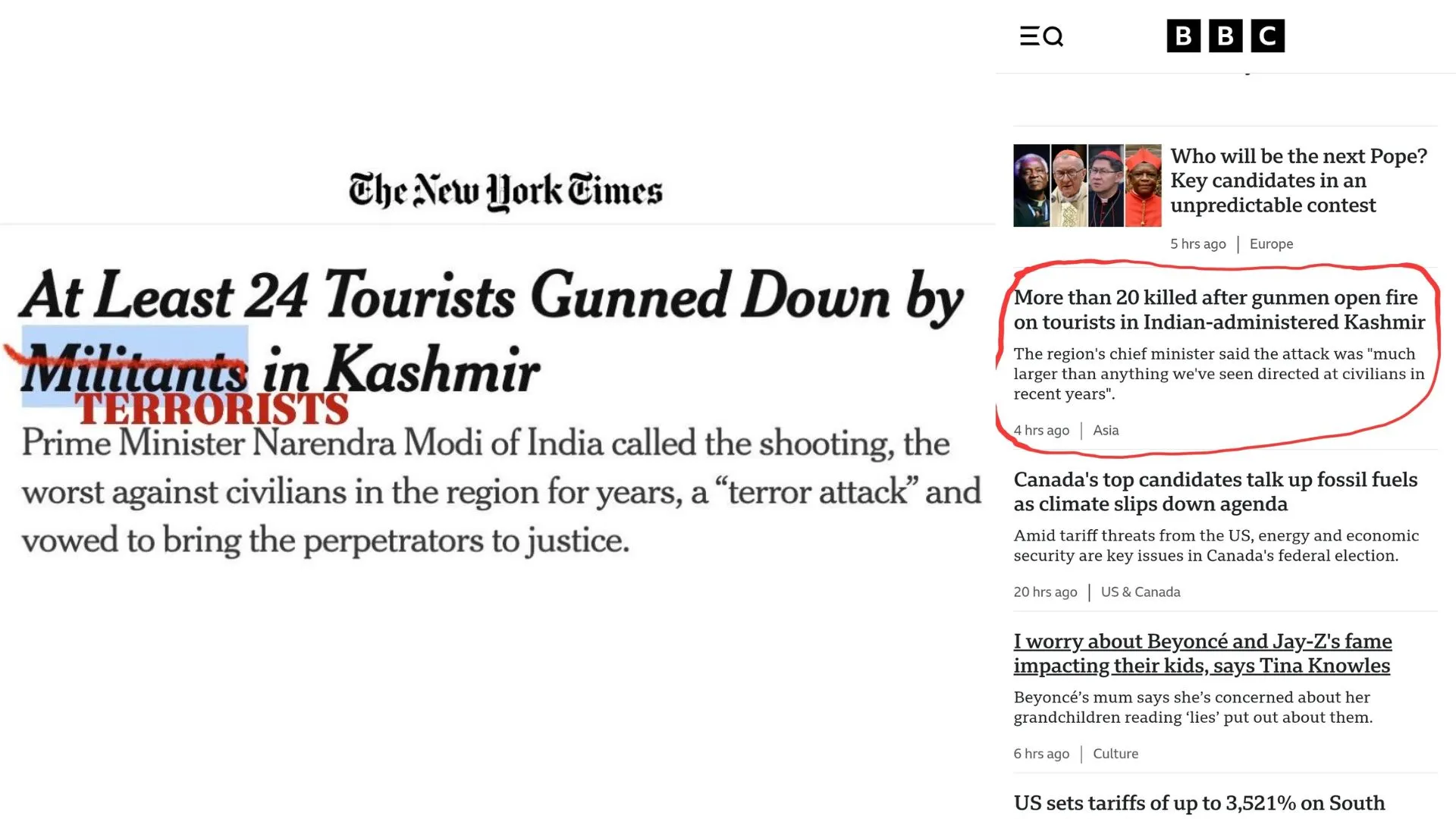In the aftermath of the Pahalgam terrorist attack in Jammu and Kashmir, where 26 tourists lost their lives, a fresh debate has erupted over the language and tone adopted by several leading international media outlets. The criticism this time isn’t limited to India—it has reached the international media.
#PahalgamTerroristAttack #Pahalgam #IndianArmy See how these clown international media report terrorist attacks on India but when these terrorists fucked his country then reporting will be different. #CNNEWS #bbc #AlJazeera @BBCWorld @CNN @AJEnglish These fucking news media . pic.twitter.com/7atAQq6L90
— Mr. Raj (@rajranjan12) April 22, 2025
The New York Times Calles Terrorists “Militants”, “Gunmen”
The New York Times’ description of the attack, using words such as “militants” and “gunmen” rather than “terrorists,” has come under sharp scrutiny. The U.S. House Foreign Affairs Committee publicly criticised the publication, stating: “Hey, @nytimes we fixed it for you. This was a TERRORIST ATTACK plain and simple.” Their statement was accompanied by an edited image of the NYT headline, replacing “militants” with “terrorists” in bold red.

This pushback stems from what many perceive as a recurring editorial pattern where acts of terrorism in India, particularly in Kashmir, are presented through a diluted or ambiguous lens. The NYT’s framing was widely viewed as diminishing the brutality of the attack and projecting Indian government statements as mere political rhetoric.
Al Jazeera and BBC Calls – ‘Indian Administered Kashmir’
The Resistance Front (TRF), a proxy outfit of Pakistan-based Lashkar-e-Taiba, claimed responsibility for the Pahalgam attack. Yet, global outlets like Al Jazeera and BBC continued using terms that imply contested legitimacy, such as “Indian-administered Kashmir”, even while reporting on unprovoked killings of civilians by known terrorist groups.
BBC should also be given 48 hours to pack up and shift to the land they clearly serve – Pakistan.
When Hindus are killed by Pakistani terrorists in Bharat, and your headline still says “Indian-administered Kashmir”, you are not reporting.
You are running PR for jihad.This is… pic.twitter.com/VGrlpReAy3
— Ge(r)ms of Bollywood बॉलीवुड के रत्न (@GemsOfBollywood) April 24, 2025
This #AlJazeera report starts and ends with blaming of #India for what happened in #Pahalgam. The entire narrative is as usual tinged with #Islamist propaganda. An earlier version of the report even said that the attack happened amid “heavy military crackdown” in #Kashmir by… pic.twitter.com/OYfPGsRXdm
— Sreeram Chaulia (@sreeramchaulia) April 23, 2025
Al Jazeera’s report drew specific ire for allegedly framing the attack within a narrative of “Indian military crackdowns,” with critics accusing it of leaning on Islamist propaganda and undermining India’s sovereign efforts to combat terrorism. Analysts argue that this kind of coverage whitewashes the actions of terror outfits and blurs the line between victims and perpetrators.
International Leaders Joins For Peace And Justice
The United States government’s reaction marks a notable moment. President Donald Trump and Vice President JD Vance both extended their condolences to Prime Minister Narendra Modi and assured full American support in India’s fight against terrorism. Trump’s message, in particular, was unequivocal in condemning the attack and rejecting any softening of its description.
Moreover, the White House recently targeted The New York Times over another unrelated article, suggesting a broader frustration with what it sees as ideological bias or selective framing within the outlet’s editorial practices.
Islamist Narrative Building ? Netizens React
In India, criticism of foreign media coverage has grown sharper. Calls have been made to review the operations of organisations like the BBC, citing repeated biases and insensitive reporting. Many argue that by failing to name terrorism for what it is, such outlets act more like platforms for geopolitical agendas rather than neutral observers of global events.
BBC is a master of deceitful narrative-building. How will any outsider not be misled by this twisted headline on the Pahalgam terror attack?
Utter disgrace- shame on you, BBC! pic.twitter.com/Xta4faCGvi— Meru (@MeruBhaiya) April 25, 2025
A user on X said, “When Hindus are killed by Pakistani terrorists in Bharat, and your headline still says ‘Indian-administered Kashmir,’ you are not reporting. You are running PR for jihad.”






















